-
01-01-2017
Pelvic floor rehabilitation program: report of 10 years of experience
Revista Brasileira de Enfermagem. 2017;70(1):231-235
Abstract
Pelvic floor rehabilitation program: report of 10 years of experience
Revista Brasileira de Enfermagem. 2017;70(1):231-235
DOI 10.1590/0034-7167-2016-0257
Views0See moreABSTRACT
Objective:
to relate the creation, experience of establishment and service performed in the Pelvic Floor Rehabilitation Program [(PRAP)], a project of the School of Nursing of University of Campinas (UNICAMP), developed at a health unity in Campinas, São Paulo, Brazil.
Results:
this Program appeared due to the high demand of patients with urinary incontinence (UI) and need of formation or qualification of professionals to serve those customers and multiply the actions at other health unities. Nowadays, the PRAP is in its tenth year, and it has served 102 patients with UI and other dysfunctions of the pelvic floor and lower urinary tract, qualified 480 health professionals and stimulated researches.
Conclusion:
the preventive actions of pelvic floor rehabilitation are important areas of the nurse’s performance and initiatives as the related ones contribute for the professional formation and practice based on evidences.
-
01-01-2017
Nursing process in mental health: an integrative literature review
Revista Brasileira de Enfermagem. 2017;70(1):220-230
Abstract
Nursing process in mental health: an integrative literature review
Revista Brasileira de Enfermagem. 2017;70(1):220-230
DOI 10.1590/0034-7167-2016-0031
Views0See moreABSTRACT
Objective:
to identify evidences from the literature on the application of nursing process in care developed by the nurse in mental health.
Method:
integrative literature review between 1990 and 2013, in the PubMed, Scopus, CINAHL and LILCACS bases. Descriptors: nursing processes, mental health, nursing care.
Results:
19 papers were identified. Limited and partial usage of the nursing process in care established by a therapeutic relationship that respects the patient’s individuality. We observe care proposals systematized for patients that present pathological aspects in the limits between the physical and psychical, which might be a response to the influence of the practice based on evidences.
Conclusion:
it was found an antagonistic movement between care based on the relationship and located in the standardization of diagnoses that respond to physical malaise. A lack of evidence was verified for the usage of the nursing process in mental health, and we point at the necessity for the creation of new possibilities for dialogue between relational and biological perspectives.
-
01-01-2017
Nursing practice in home care: an integrative literature review
Revista Brasileira de Enfermagem. 2017;70(1):210-219
Abstract
Nursing practice in home care: an integrative literature review
Revista Brasileira de Enfermagem. 2017;70(1):210-219
DOI 10.1590/0034-7167-2016-0214
Views0See moreABSTRACT
Objective:
analyze scientific production on nursing practice in home care.
Method:
integrative review employing databases LILACS, BDENF, IBECS, and MEDLINE. Studies in Spanish, English, and Portuguese were included, regardless of publishing date.
Results:
after analyzing 48 articles, it was found that nursing practice in home care is complex, employing a multitude of actions by using three technologies: soft; soft-hard especially; and hard. Challenges related to the home-care training process are reported in the literature. Nurses use knowledge from their experience and scientific recommendations in conjunction with their reflections on the practice.
Conclusion:
home nursing practice is fundamental and widespread. Relational and educational actions stand out as necessary even in technical care, with a predominant need for home-care training.
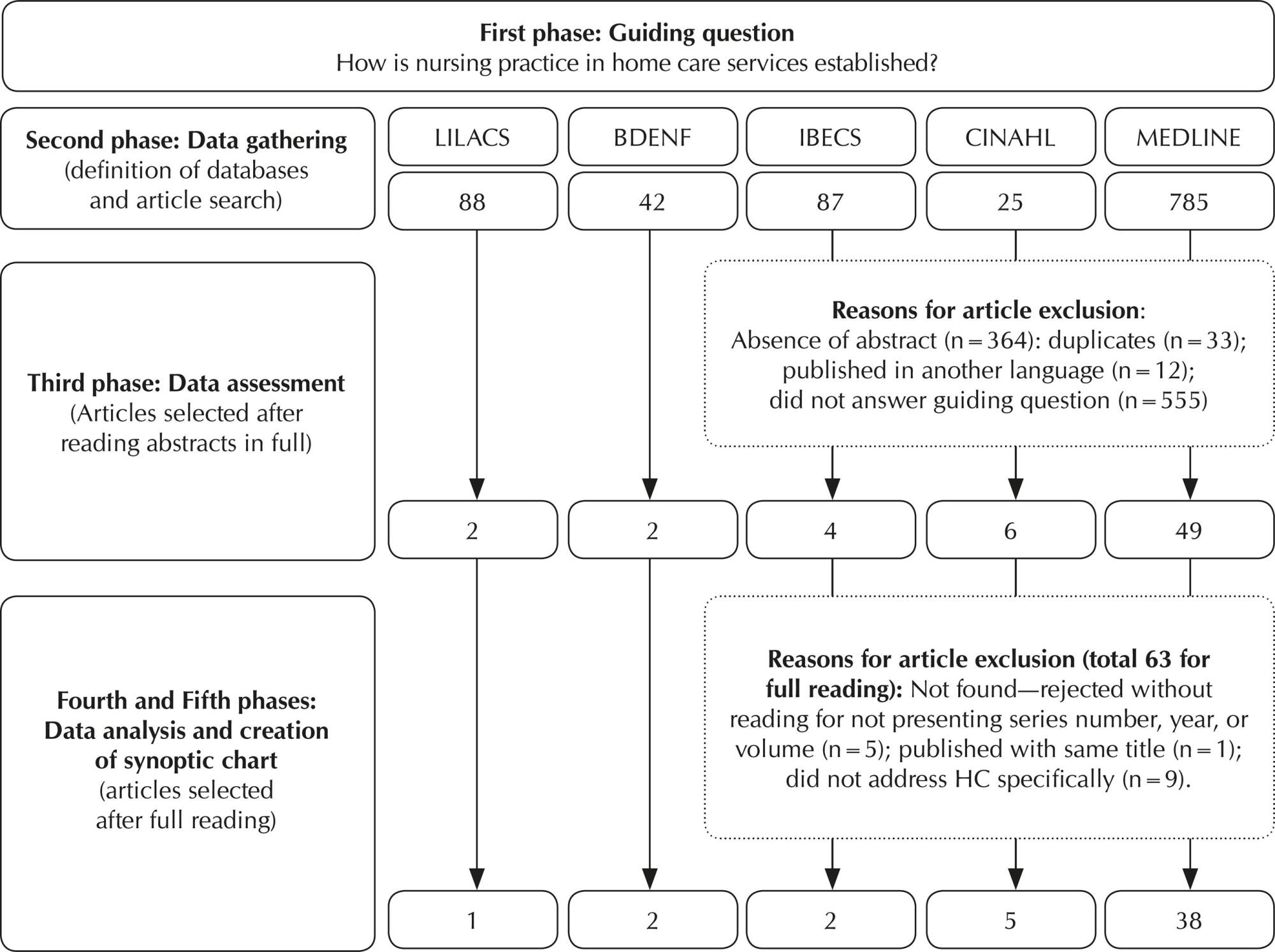
-
01-01-2017
Nonpharmacological interventions to improve quality of life in heart failure: an integrative review
Revista Brasileira de Enfermagem. 2017;70(1):198-209
Abstract
Nonpharmacological interventions to improve quality of life in heart failure: an integrative review
Revista Brasileira de Enfermagem. 2017;70(1):198-209
DOI 10.1590/0034-7167-2016-0112
Views0See moreABSTRACT
Objective:
to identify articles that assessed the effectiveness or efficacy of nonpharmacological interventions to improve quality of life of people with heart failure in the literature.
Method:
an integrative literature review was performed in Lilacs, MedLine and SciELO databases, including randomized or nonrandomized clinical trials and quasi-experimental studies published between 2003 and 2014, in Portuguese, English or Spanish.
Results:
twenty-three studies were included. The categories of nonpharmacological interventions that improved quality of life of people with heart failure were: Remote health monitoring, Instructions on health practices, Physical activity follow-up and Traditional Chinese Medicine practices.
Conclusion:
these results can guide the selection of interventions to be implemented by health professionals that treat people with heart failure. Future systematic reviews with meta-analyses are needed in order to identify the most effective interventions for improving these individuals’ quality of life.
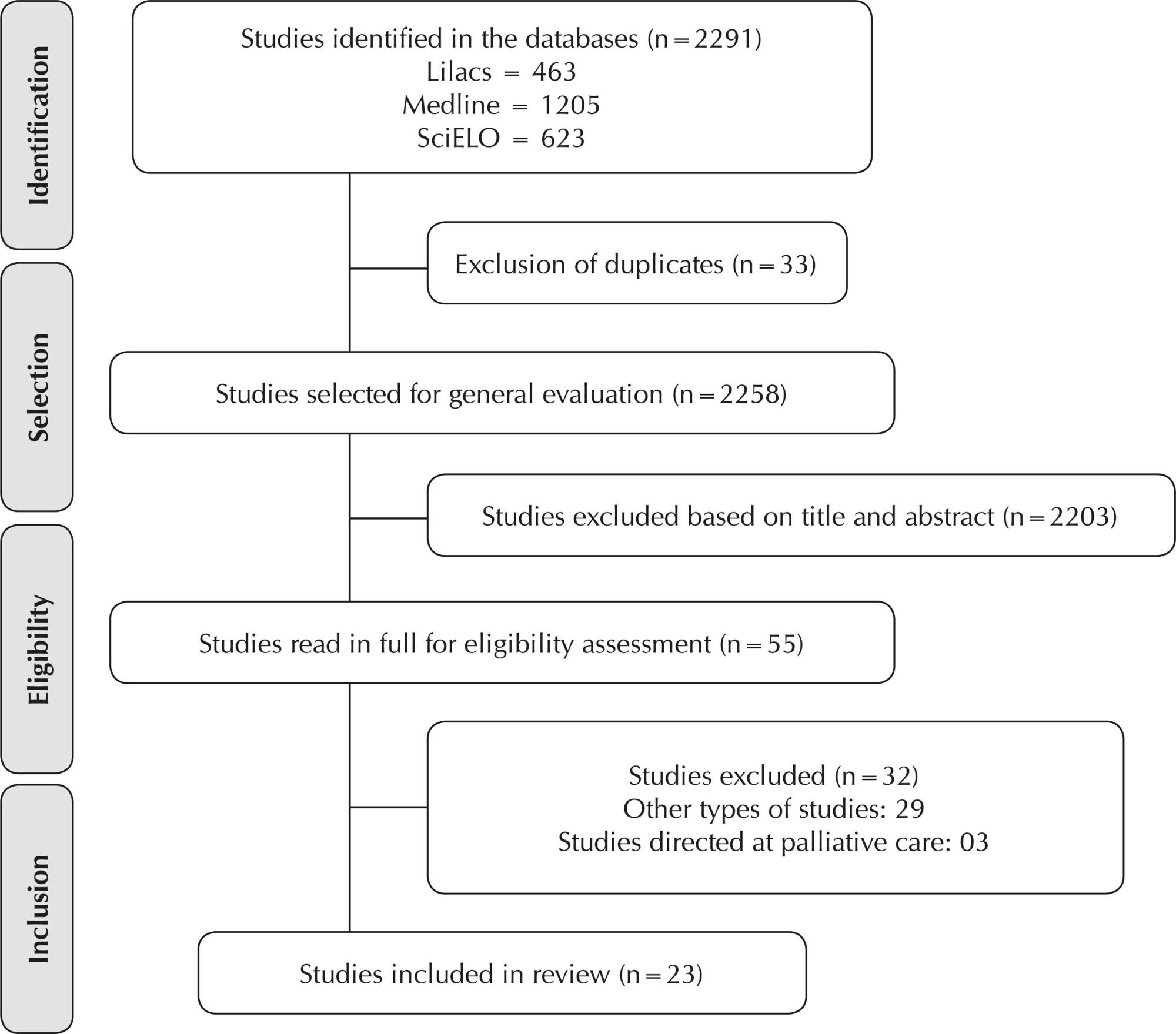
-
01-01-2017
Quality of working life: assessment of intervention studies
Revista Brasileira de Enfermagem. 2017;70(1):189-197
Abstract
Quality of working life: assessment of intervention studies
Revista Brasileira de Enfermagem. 2017;70(1):189-197
DOI 10.1590/0034-7167-2015-0069
Views0See moreABSTRACT
Objective:
to analyze the production of knowledge about interventions on quality of working life.
Method:
integrative review study. The following databases were used for study selection: SciELO, Medline and PubMed.
Results:
the sample included 25 national and international articles that described programs and methods to acquire healthy habits at the workplace and attenuate its mental demands.
Conclusion:
by observing the number of businesses throughout the world, a low number of programs addressing workers’ health and well-being can be found, and the establishment of efficient policies at institutions could improve this situation.
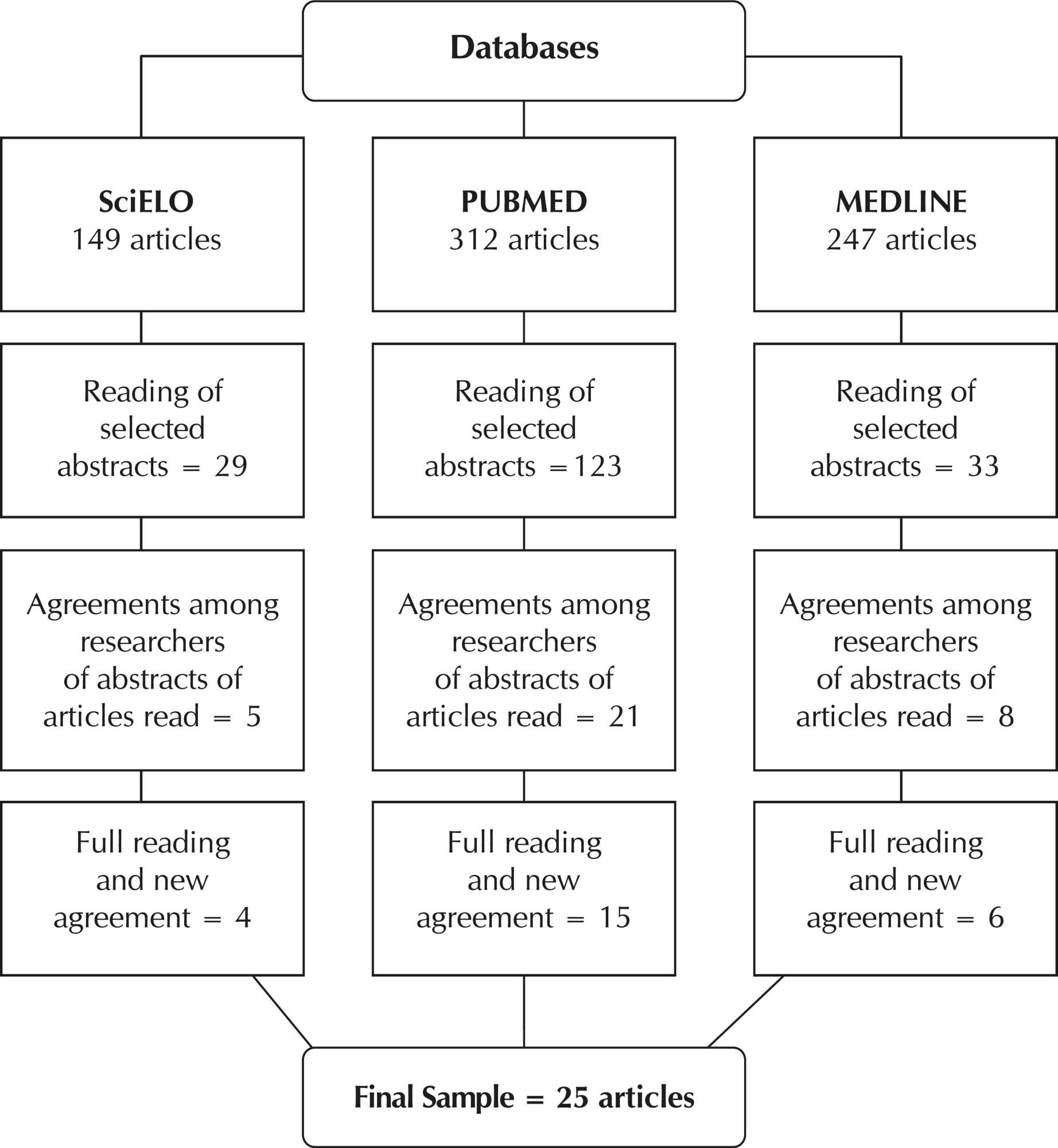
-
REVIEW01-01-2017
Health literacy for people living with HIV/Aids: an integrative review
Revista Brasileira de Enfermagem. 2017;70(1):180-188
Abstract
REVIEWHealth literacy for people living with HIV/Aids: an integrative review
Revista Brasileira de Enfermagem. 2017;70(1):180-188
DOI 10.1590/0034-7167-2015-0052
Views0See moreABSTRACT
Objective:
to analyze knowledge produced by research about health literacy for adult with HIV/Aids.
Method:
an integrative literature review, using six databases, was conducted between January and April of 2014. The descriptors aids and Health Literacy were used, in Portuguese, English and Spanish. A total of 130 articles were found and 14 were selected. Three categories were identified: educational technologies and health literacy for HIV/Aids; assessment of health literacy of patients with HIV/Aids; and health literacy and adherence to antiretroviral therapy.
Results:
analysis of health literacy, socioeconomic status and educational level of people living with HIV/ Aids was essential for implementation of educational strategies that increased adherence to health guidance.
Conclusion:
this study showed the importance of health literacy for working with people living with HIV/Aids, especially considering individuals who did not possess the minimum necessary for survival, which makes it relevant and encourages further research on the topic.
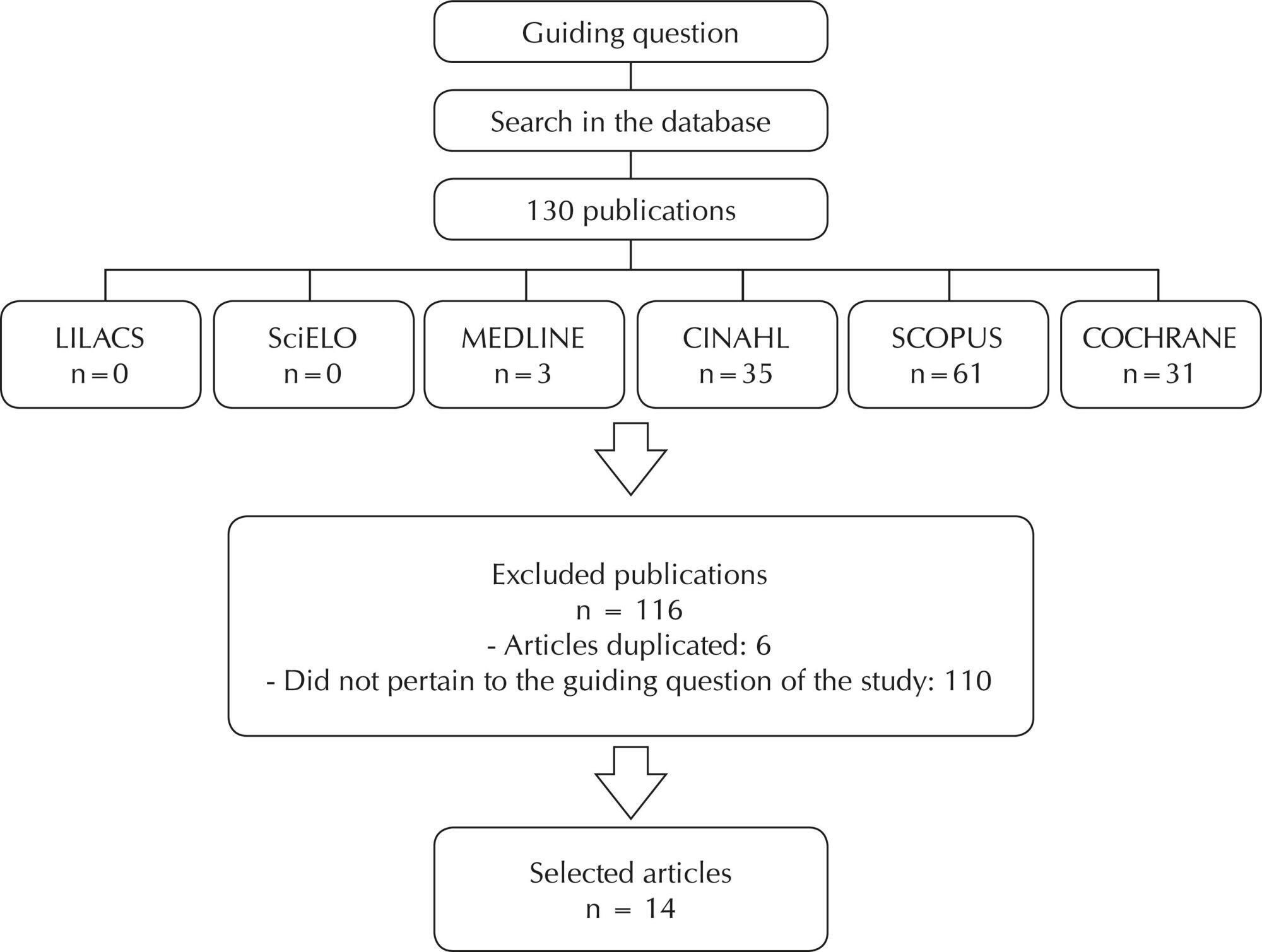
-
01-01-2017
Letramento em saúde para pessoas com HIV/Aids: revisão integrativa
Revista Brasileira de Enfermagem. 2017;70(1):180-188
Abstract
Letramento em saúde para pessoas com HIV/Aids: revisão integrativa
Revista Brasileira de Enfermagem. 2017;70(1):180-188
DOI 10.1590/0034-7167-2015-0052
Views1See moreRESUMEN
Objetivo:
analizar el conocimiento producido por la investigación sobre la salud de alfabetización para adultos con VIH/SIDA.
Método:
una revisión integradora de la literatura, con seis bases de datos, se llevó a cabo entre enero y abril de 2014. Los descriptores SIDA y Educación de la Salud se utilizaron, en portugués, inglés y español. Se encontró un total de 130 artículos y se seleccionaron 14. Se identificaron tres categorías: tecnologías de la educación y alfabetización de la salud para el VIH/SIDA; evaluación de conocimientos sobre la salud de los pacientes con VIH/SIDA; y conocimientos sobre la salud y la adherencia a la terapia antirretroviral.
Resultados:
análisis de los conocimientos sobre la salud, el estatus socioeconómico y nivel educativo de las personas que viven con el VIH / SIDA era esencial para la implementación de estrategias educativas que el aumento de la adherencia a la orientación de la salud.
Conclusión:
Este estudio demostró la importancia de la alfabetización en salud para trabajar con personas que viven con el VIH / SIDA, especialmente teniendo en cuenta a las personas que no poseen el mínimo necesario para la supervivencia, lo que hace que sea aún más relevante y alienta la investigación sobre el tema.
-
01-01-2017
Factors that interfere with the response of nurses in the monitoring of clinical alarms
Revista Brasileira de Enfermagem. 2017;70(1):172-179
Abstract
Factors that interfere with the response of nurses in the monitoring of clinical alarms
Revista Brasileira de Enfermagem. 2017;70(1):172-179
DOI 10.1590/0034-7167-2015-0092
Views0See moreABSTRACT
Objective:
The objective of the present study was to identify and synthesize the best empirical evidence found on factors that influence the response of nurses regarding clinical alarms.
Method:
An integrative literature review was conducted with searches undertaken in ten electronic databases restricted to the period from 2005 to 2016.
Results:
Eight articles were included by cross-checking the descriptors selected.
Conclusion:
In the analysis of the studies, the following possible factors that might interfere with the response of nurses in the monitoring of clinical alarms were found: high number of false alarms, inaudibility of alarms due to the competition of sounds, difficulty in distinguishing the urgency of alarms, and increase in noise caused by the raise in the number of alarms.
-
ORIGINAL ARTICLE06-16-2021
The meaning of nursing 200 years after Nightingale – perceptions of professional practice in the intensivist context
Revista Brasileira de Enfermagem. 2021;74(2):e20200364
Abstract
ORIGINAL ARTICLEThe meaning of nursing 200 years after Nightingale – perceptions of professional practice in the intensivist context
Revista Brasileira de Enfermagem. 2021;74(2):e20200364
DOI 10.1590/0034-7167-2020-0364
Views0See moreABSTRACT
Objectives:
to know the meaning of contemporary nursing from the experience of intensive care nurses.
Methods:
qualitative research based on the theoretical framework of Symbolic Interactionism and the methodological framework of Interpretive Interactionism. The setting was a general hospital in Bahia, being carried out with 12 nurses working in intensive care for at least one year, through semi-structured interviews and drawing-text-theme technique, whose data were organized according to Miles and Huberman and analyzed upon the referential.
Results:
the sense of being a nurse was evidenced; a being for care, resulting from the experience in intensive care, capable of promoting the development of professional self-image, by causing, in nurses, other skills – besides the scientific ones, such as empathy, creativity, spirituality and compassion.
Final Considerations:
the sense of being a nurse, currently, expresses developments inherited from the Nightingalean proposal, but transcends the technical-managerial emphasis of this to a humanistic care perspective converging with our contemporary professional identity: a being for care.
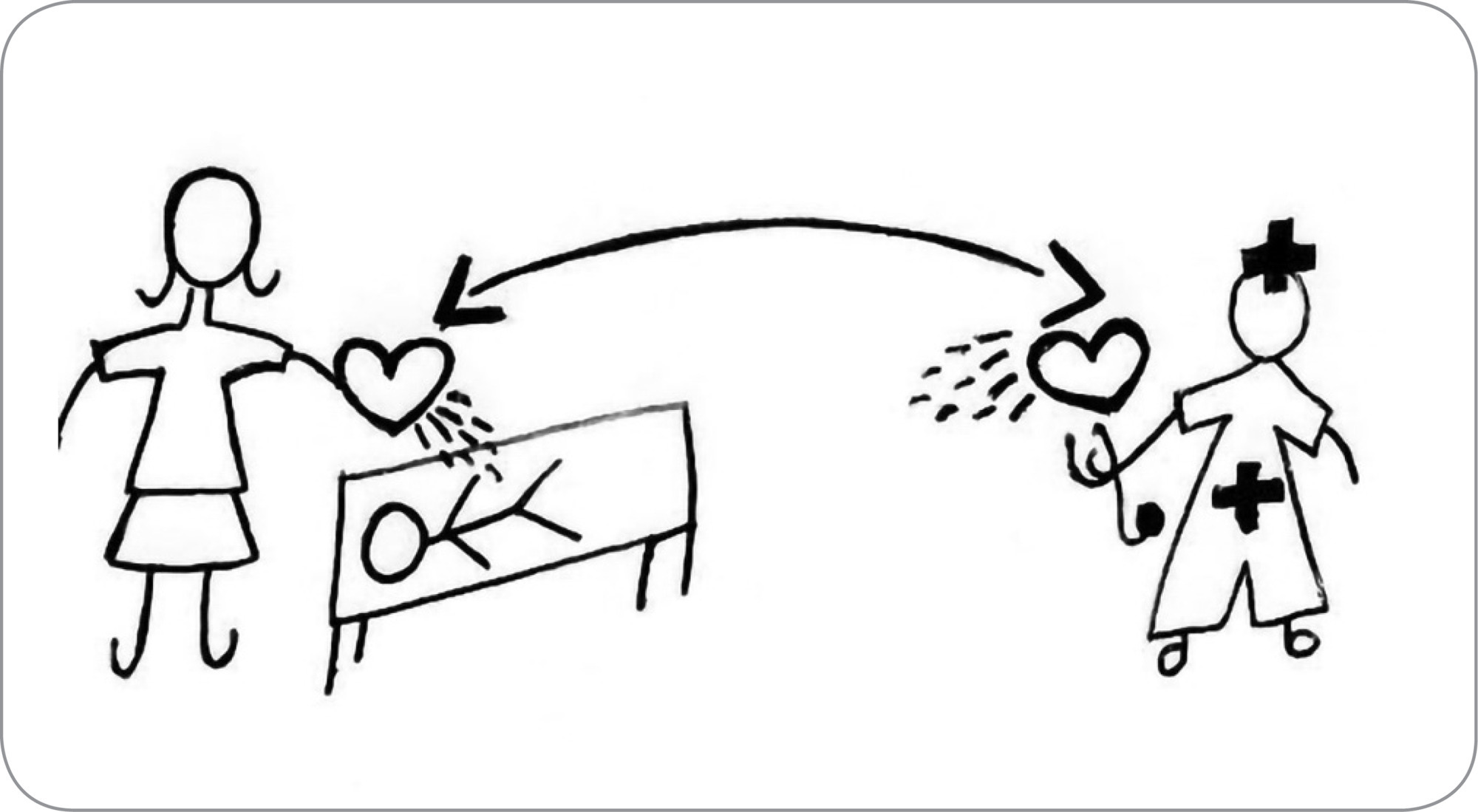
-
ORIGINAL ARTICLE05-28-2021
In(compatibility) of intravenous drugs in critical units: adult cohort
Revista Brasileira de Enfermagem. 2021;74(2):e20200501
Abstract
ORIGINAL ARTICLEIn(compatibility) of intravenous drugs in critical units: adult cohort
Revista Brasileira de Enfermagem. 2021;74(2):e20200501
DOI 10.1590/0034-7167-2020-0501
Views1See moreABSTRACT
Objectives:
To analyze potential (in)compatibilities of intravenous drugs based on the scheduling prepared by the nursing team.
Methods:
historic cohort (retrospective) with 110 adults in critical units. Intravenous medications were identified concomitantly, whose pairs were analyzed for (in) compatibility using the screening system Trissel’s™ 2 Compatibility IV-Micromedex 2.0. Parametric and non-parametric statistic were used according to the nature of the variable.
Results:
565 pairs of drugs were identified. Of these, 44.9% were compatible; and 8.8%, potentially incompatible. Most potentially incompatible pairs involved substances with alkaline pH such as phenytoin (32%) and sodium bicarbonate (8%) and weak acids such as midazolam (12%) and dobutamine (6%), which could result in precipitate formation.
Conclusions:
almost half of the mixtures simultaneously administrated was compatible, which indirectly reflects in the organized work between the nursing team and the clinical pharmaceutic in the discussions and decisions related to time scheduling.
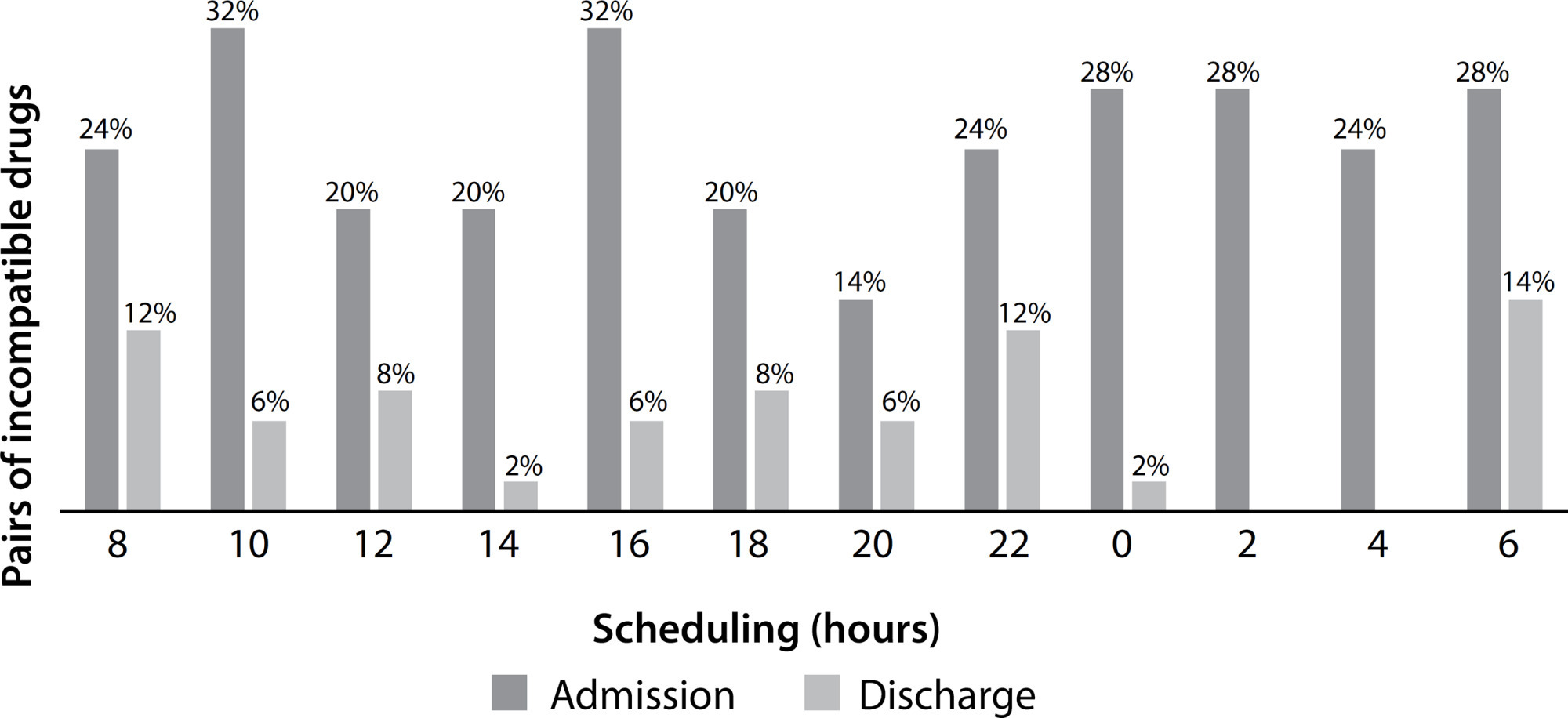
-
ORIGINAL ARTICLE05-28-2021
Prevalence and severity levels of post-radical prostatectomy incontinence: different assessment instruments
Revista Brasileira de Enfermagem. 2021;74(2):e20200692
Abstract
ORIGINAL ARTICLEPrevalence and severity levels of post-radical prostatectomy incontinence: different assessment instruments
Revista Brasileira de Enfermagem. 2021;74(2):e20200692
DOI 10.1590/0034-7167-2020-0692
Views1See moreABSTRACT
Objectives:
to analyze urinary incontinence prevalence and severity in prostatectomized men assessed by three different instruments.
Methods:
a cross-sectional study was conducted with 152 men. The pad test, pad used, and International Consultation on Incontinence Questionnaire – Short Form (self-report) were considered. Data were analyzed using Spearman’s correlation, Kappa index, considering a significance level of 0.05.
Results:
urinary incontinence prevalence was 41.4%, 46.7% and 80.3% according to pad used, pad test and self-report. Positive correlations and moderate to poor agreement were found between the instruments. As for severity, most participants had mild incontinence. The largest number of cases of mild and severe incontinence was identified by self-report.
Conclusions:
the self-report showed higher values for prevalence of mild and severe severity levels. Through the identified differences, we propose that the objective assessment (pad used and pad test) be associated with individuals’ perception (self-report) to better estimate prevalence and severity.

-
ORIGINAL ARTICLE05-28-2021
Cultural adaptation and validation of an instrument about nursing critical thinking skills
Revista Brasileira de Enfermagem. 2021;74(2):e20200720
Abstract
ORIGINAL ARTICLECultural adaptation and validation of an instrument about nursing critical thinking skills
Revista Brasileira de Enfermagem. 2021;74(2):e20200720
DOI 10.1590/0034-7167-2020-0720
Views1See moreABSTRACT
Objectives:
to validate the Nursing Critical Thinking in Clinical Practice Questionnaire regarding cultural aspects and metric properties.
Methods:
a methodological research carried out through cross-cultural adaptation, face and content validity, dimensional construct and known groups validity, test-retest reliability and internal consistency. 511 nurses from four hospitals participated in the study, of which 54 participated in retest.
Results:
the instrument validation for Brazilian Portuguese maintained equivalences, according to the original version. The dimensional validity demonstrated adjustment to the tetrafactorial structure of the original version (GFI=0.69). There were statistically significant differences in critical thinking skills between nurses with graduate degrees and who undertook training, reading articles, developing research and working in an institution with a longer time implementation of the Nursing Process. The instrument showed temporal stability (ICC 073-0.84; p<0.001) and adequate internal consistency (α=0.97).
Conclusions:
the instrument proved to be valid and reliable for the studied population.
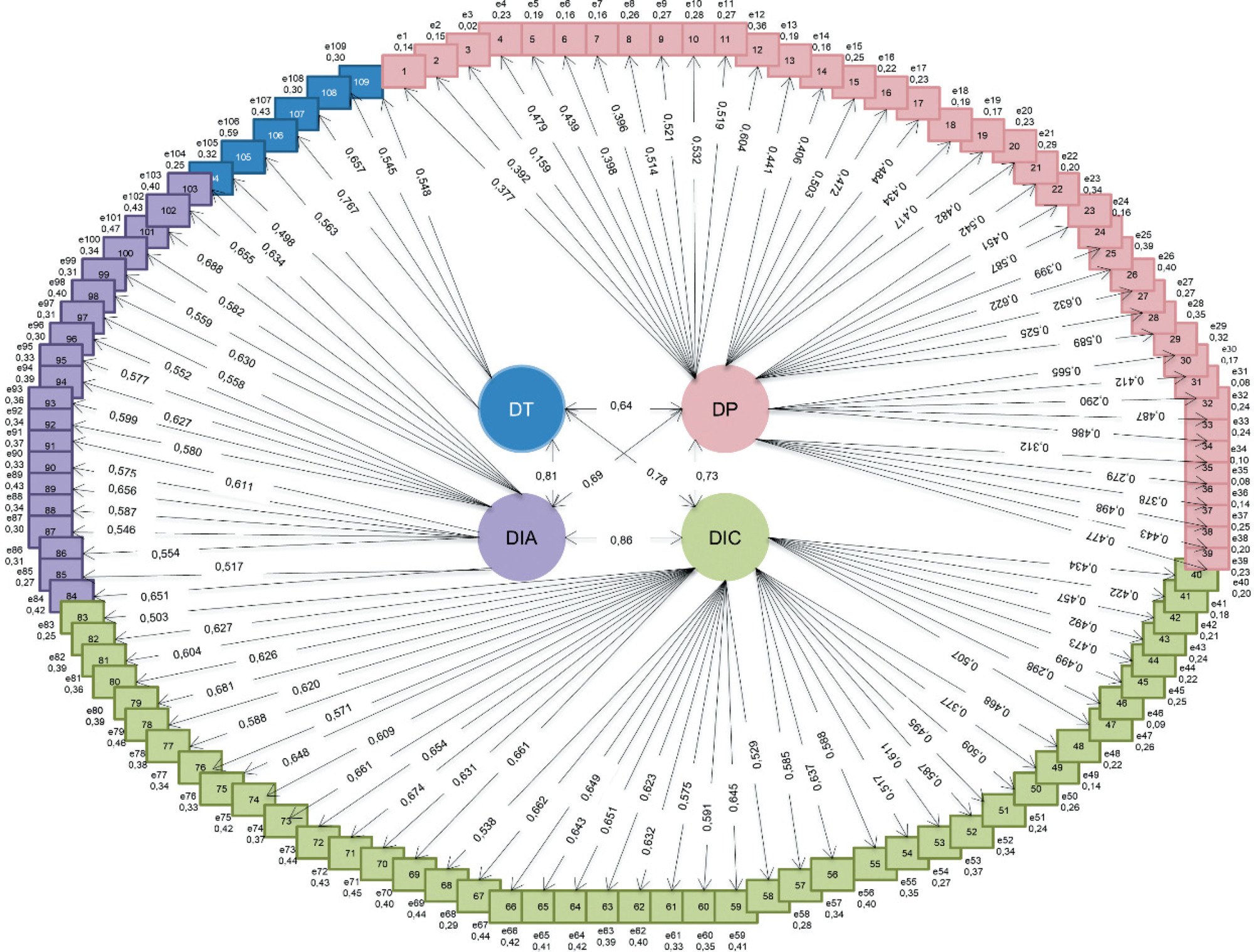
-
REVIEW05-21-2021
Evaluation strategies in active learning in higher education in health: integrative review
Revista Brasileira de Enfermagem. 2021;74(2):e20201055
Abstract
REVIEWEvaluation strategies in active learning in higher education in health: integrative review
Revista Brasileira de Enfermagem. 2021;74(2):e20201055
DOI 10.1590/0034-7167-2020-1055
Views0See moreABSTRACT
Objectives:
to analyze scientific evidence on evaluation strategies for active learning methods in health undergraduate programs.
Methods:
integrative literature review in the Medical Literature Analysis and Retrieval System Online, Latin American and Caribbean Literature in Health Sciences, Nursing Database, Scopus, Web of Science and Education Resources Information Center databases.
Results:
different evaluation strategies are used: Presentation of seminars, Self-evaluation, Evaluation of student performance in Tutotest-Lite tutoring, Peer Evaluation, Active Learning and Critical Thinking Self-evaluation Scale, Objective and Structured Clinical Exam, Portfolio, Progressive Disclosure Questions, Modified Dissertation Questions, Progression Test, Dissertation Test, Objective Test, Immediate Learning Checks, Clinical Case Resolution and Cumulative Test.
Final Considerations:
evaluation strategies in active learning are used in combination, aiming at the affective, cognitive and psychomotor development of the student. However, studies with greater power of scientific evidence would be needed.
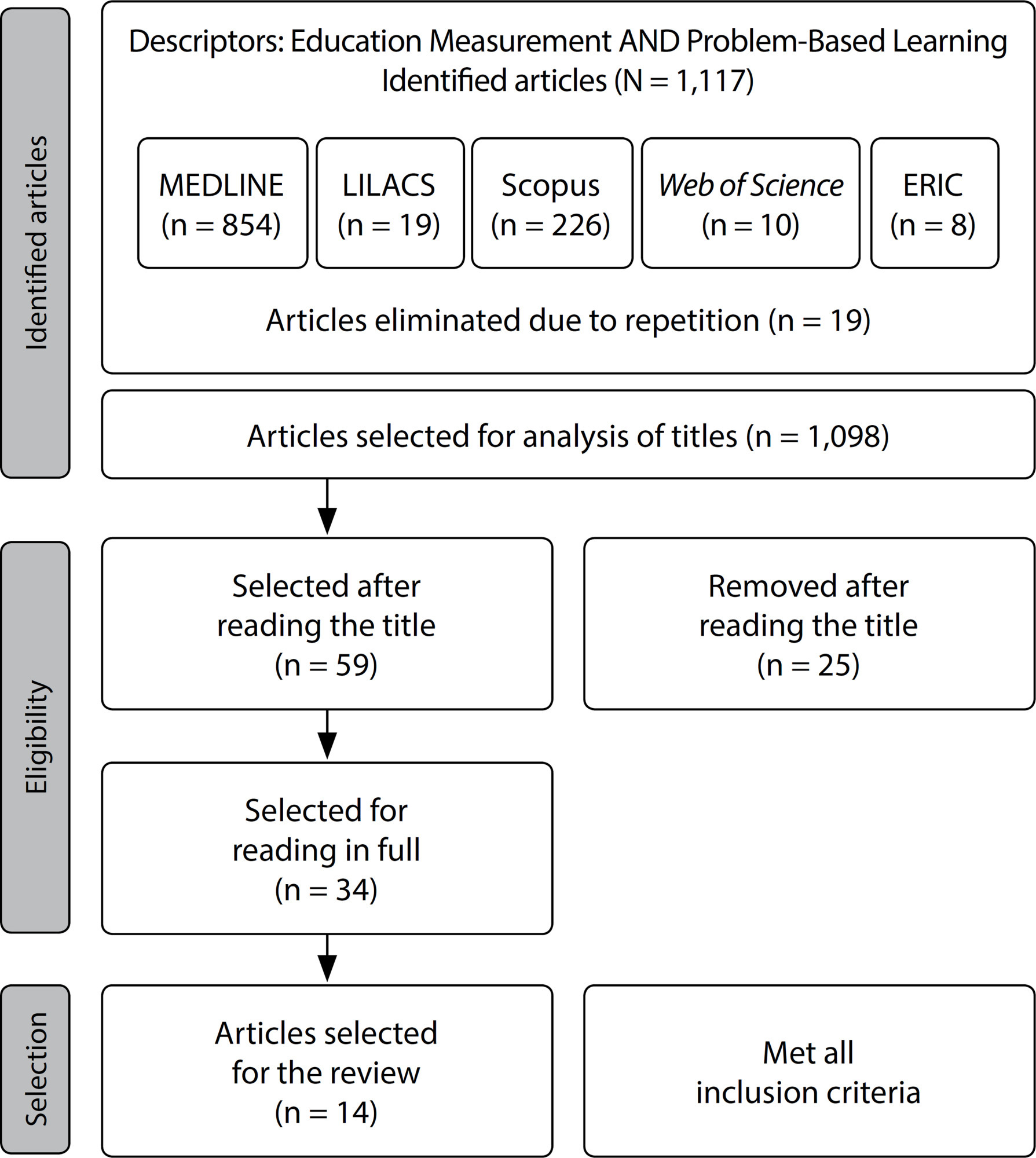
-
ERRATUM04-14-2021
ERRATUM
Revista Brasileira de Enfermagem. 2021;74(2):e2021n2e04
Abstract
ERRATUMERRATUM
Revista Brasileira de Enfermagem. 2021;74(2):e2021n2e04
DOI 10.1590/0034-7167.20217402e04
Views1Article “Obstetric analgesia in labor and its association with neonatal outcomes”, with number of DOI: , published in the journal Revista Brasileira de Enfermagem, 73(5):e20190157, in the header:Where to read:[…]See more -
ORIGINAL ARTICLE07-09-2021
Brazilian Nursing Association: fight for space in the new federal capital
Revista Brasileira de Enfermagem. 2021;74(3):e20200701
Abstract
ORIGINAL ARTICLEBrazilian Nursing Association: fight for space in the new federal capital
Revista Brasileira de Enfermagem. 2021;74(3):e20200701
DOI 10.1590/0034-7167-2020-0701
Views0See moreABSTRACT
Objectives:
to analyze the transfer process of the Brazilian Nursing Association to its new headquarters in Brasília/Federal District.
Methods:
qualitative, socio-historical, and documental study. The analysis generated the following characteristics: Associate reorganization: the transfer from the Central ABEn headquarters; and the Strategies used in the struggle for the appropriation of space.
Results:
the Brazilian Nursing Association was engaged in a struggle, which lasted nine years, for the acquisition of land in the new Federal Capital, Brasília, to ensure a prestigious place for the Association, and for nursing as well.
Final Considerations:
together with their sections, undertook efforts and implemented strategies to find a space in the new Federal Capital, allowing visibility and recognition to the nursing profession.
-
REVIEW06-07-2021
Tuberculosis/HIV coinfection from the perspective of quality of life: scope review
Revista Brasileira de Enfermagem. 2021;74(3):e20200758
Abstract
REVIEWTuberculosis/HIV coinfection from the perspective of quality of life: scope review
Revista Brasileira de Enfermagem. 2021;74(3):e20200758
DOI 10.1590/0034-7167-2020-0758
Views0See moreABSTRACT
Objectives:
to analyze evidence on the quality of life of people with tuberculosis/HIV coinfection.
Methods:
review that followed steps of the Cochrane Collaboration, with the search of publications in the bases Embase, LILACS, PubMed, and Cochrane, through the descriptors “HIV,” “Tuberculosis,” and “Quality of Life,” without a temporal cut.
Results:
the results include 15 studies, published between 2009 and 2019, with the level of evidence V, in its majority. It was observed that there is no uniformity in the instrument used. Psychological support to this group and strengthening of actions to manage both infections are necessary. This segment’s quality of life is associated with social factors and scientific production on the subject concentrated in underdeveloped countries.
Conclusions:
the articles found have a low level of scientific evidence and indicate that people who experience coinfection have a more compromised quality of life when compared to those who experience tuberculosis or HIV separately.
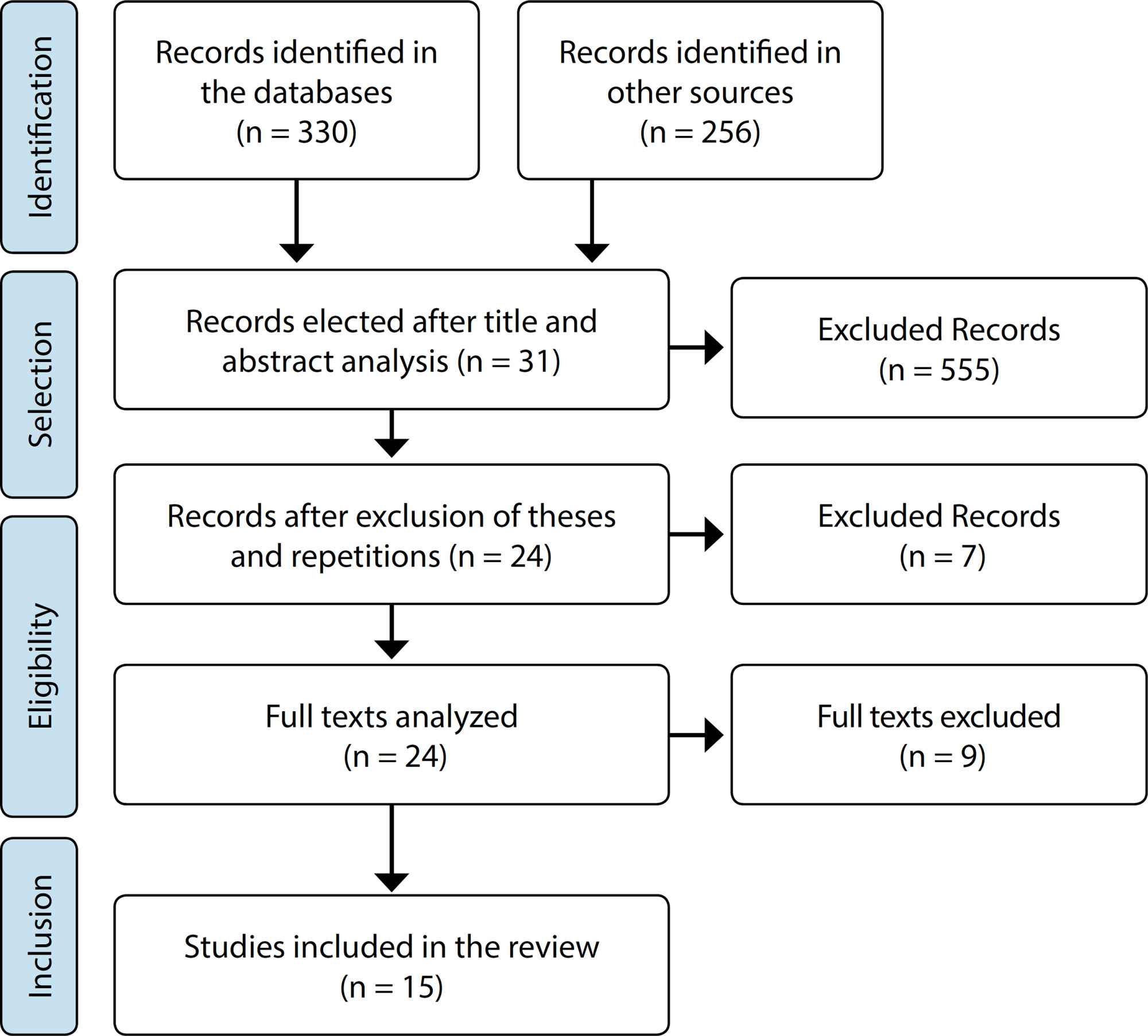
-
ORIGINAL ARTICLE08-19-2019
Functional capacity and social support to people affected by cerebrovascular accident
Revista Brasileira de Enfermagem. 2019;72(4):868-873
Abstract
ORIGINAL ARTICLEFunctional capacity and social support to people affected by cerebrovascular accident
Revista Brasileira de Enfermagem. 2019;72(4):868-873
DOI 10.1590/0034-7167-2017-0854
Views0See moreABSTRACT
Objective:
To investigate the functional capacity and its relationship with the level of social support to people affected by cerebrovascular accident.
Methods:
Cross-sectional and quantitative research, conducted with 108 individuals with sequelae of cerebrovascular accident in João Pessoa/PB. Data were collected through interviews, using a sociodemographic instrument – the Barthel Index and the Social Support Scale.
Results:
We observed the prevalence of functional dependency in 93.5%, and the mild dependency stood out in 40.7%. Medium social support was the most found, with 48.2%. The predominant dimensions of social support were the material dimension, followed by the emotional. There was a significant association (p ≤ 0.05) between very serious dependency and high social support.
Conclusion:
The results found allow us to reflect on the need for involvement of health professionals in strengthening the social support of patients with disabling diseases, such as the cerebrovascular accident.
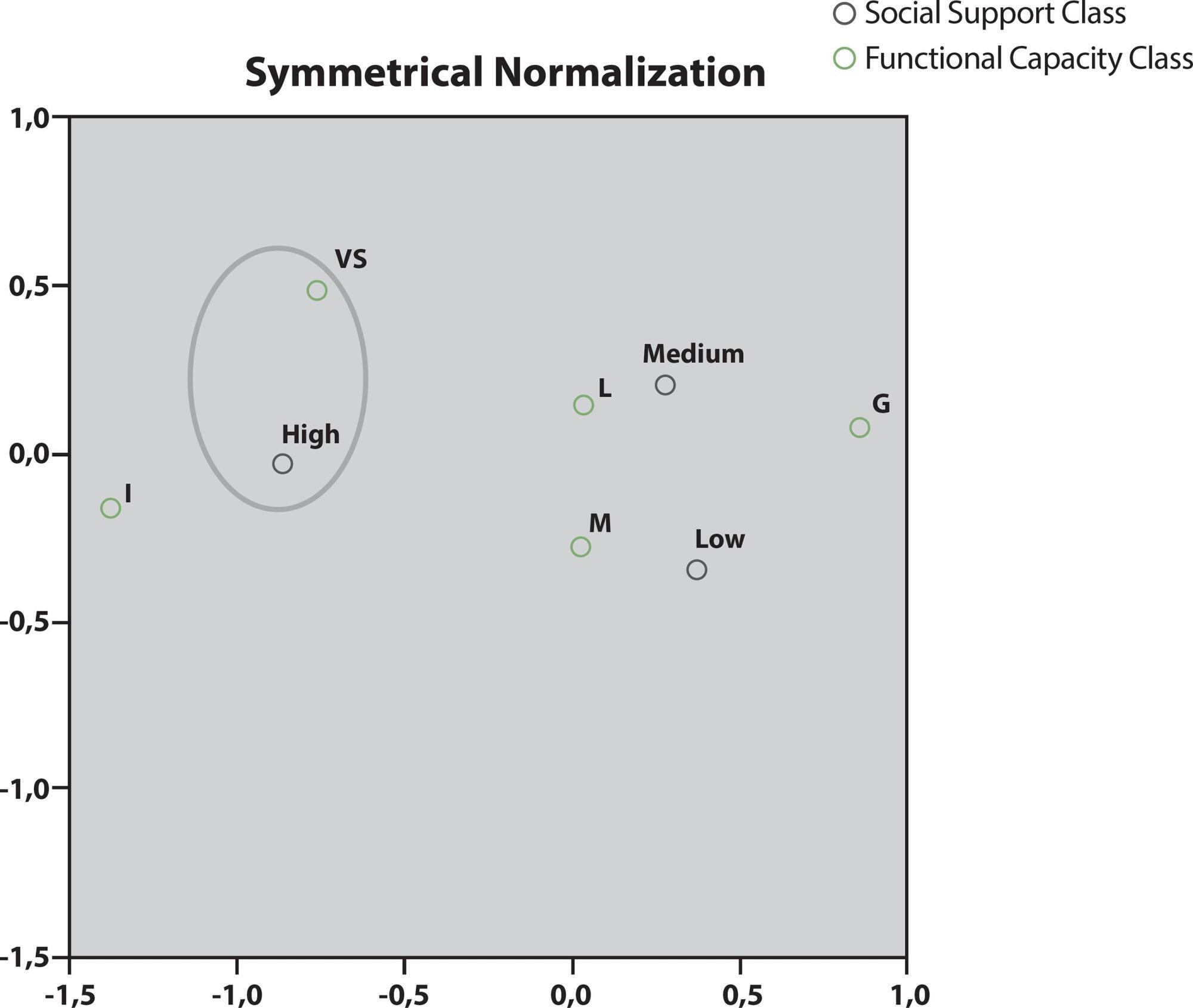
-
ORIGINAL ARTICLE11-26-2022
Vulnerability and quality of life of older persons in the community in different situations of family care
Revista Brasileira de Enfermagem. 2022;75:e20210034
Abstract
ORIGINAL ARTICLEVulnerability and quality of life of older persons in the community in different situations of family care
Revista Brasileira de Enfermagem. 2022;75:e20210034
DOI 10.1590/0034-7167-2021-0034
Views0See moreABSTRACT
Objective:
to correlate socio-contextual aspects, physical vulnerability and quality of life of older persons in the community in different situations of family care.
Methods:
epidemiological, a cross-sectional and analytical study, with elderly people in the community (n=769), with application of the instruments: Vulnerable Elders Survey-13 (VES-13), World Health Organization Quality of Life for Older Persons (WHOQOL-OLD) and the World Health Organization Quality of Life (WHOQOL-BREF); and socio-contextual data questionnaire.
Results:
the population assessed presented an average of regular quality of life in both the WHOQOL-BREF and the WHOQOL-OLD. Older non-vulnerable persons (62.2%) and those with close family contact (82.6%) have a better quality of life than the vulnerable (p<0.0001).
Conclusion:
lower quality of life scores and more distant families are related to vulnerable elderly people; thus, the assessment of family proximity and physical vulnerability of older persons is shown to be an important factor in improving quality of life.
-
ORIGINAL ARTICLE03-30-2020
Risk and protective factors for sudden infant death syndrome
Revista Brasileira de Enfermagem. 2020;73(2):e20190458
Abstract
ORIGINAL ARTICLERisk and protective factors for sudden infant death syndrome
Revista Brasileira de Enfermagem. 2020;73(2):e20190458
DOI 10.1590/0034-7167-2019-0458
Views0See moreABSTRACT
Objectives:
To verify the occurrence of the risk and protective factors for sudden infant death syndrome during nursing consultation.
Methods:
Retrospective cohort study conducted based on medical records from a primary care unit in the municipality of São Paulo. The sample consisted of 63 infants assisted from January to December 2016.
Results:
The average age of infants was 3.2 months. The main risk factors identified were the presence of soft objects in the crib (93.6%) and bed sharing (58.7%). Predominant protective factors were breastfeeding (95.2%) followed by updated immunization (90.5%).
Conclusions:
Risk and protective factors for sudden infant death syndrome were identified in the study sample, indicating the importance of addressing the issue with families of children under 1 year of age to prevent the occurrence of such events.
-
ORIGINAL ARTICLE03-30-2020
Professional skills for health promotion in caring for tuberculosis patients
Revista Brasileira de Enfermagem. 2020;73(2):e20180943
Abstract
ORIGINAL ARTICLEProfessional skills for health promotion in caring for tuberculosis patients
Revista Brasileira de Enfermagem. 2020;73(2):e20180943
DOI 10.1590/0034-7167-2018-0943
Views0See moreABSTRACT
Objectives:
to understand the health promotion skills found in the speeches of health practitioners in care for TB patients.
Methods:
qualitative study, developed with seven practitioners involved in care for TB patients, identified from a sociocentric approach, whose speeches were submitted to analysis based on the health promotion skills model in the Galway Consensus.
Results:
there were four domains: Catalyzing change; Leadership; Planning; and Partnerships. These domains resulted from health education actions, contribution of management nursing practitioners, seeking to meet patients’ needs and articulation of professional sectors.
Final considerations:
there were some skill domains in the speeches of health practitioners, with the nurse being quoted in the development of essential skills for health promotion activities, such as catalyzing change and leading care for TB patients.
-
ORIGINAL ARTICLE04-22-2020
(Dis)continuation of care of the pre-term newborn at the border
Revista Brasileira de Enfermagem. 2020;73(3):e20180827
Abstract
ORIGINAL ARTICLE(Dis)continuation of care of the pre-term newborn at the border
Revista Brasileira de Enfermagem. 2020;73(3):e20180827
DOI 10.1590/0034-7167-2018-0827
Views0See moreABSTRACT
Objectives:
to understand how continuation of care for the preterm newborn in the health care network at the border.
Methods:
the Grounded Theory was the methodological framework. Data were collected through 17 semi-structured interviews between July 2016 and March 2017.
Results:
“Describing the structure and functioning of the Child Nutrition Center” represents the context; “Experiencing and signifying premature birth” are the causal conditions; “Identifying conditions that intervene in the process of continuation of care for the preterm newborn” are the intervening conditions; “Ensuring continuation of care for the preterm newborn” are strategies; “Identifying (dis)continuation of care flows for the preterm newborn at the border” are the study’s consequences and phenomenon.
Final Considerations:
there is a need to plan referral and counter-referral flows of the preterm newborn and the commitment of public health managers to ensure continuation of care.
-
ORIGINAL ARTICLE12-05-2019
Quality of life, burden, family emotional support: a model for older adults who are caregivers
Revista Brasileira de Enfermagem. 2019;72:169-176
Abstract
ORIGINAL ARTICLEQuality of life, burden, family emotional support: a model for older adults who are caregivers
Revista Brasileira de Enfermagem. 2019;72:169-176
DOI 10.1590/0034-7167-2018-0439
Views0See moreABSTRACT
Objective:
To investigate associations between quality of life, sex, age, burden, and nature of emotional support available in the family in older adults who are caregivers of older relatives.
Method:
Cross-sectional and correlational study on 148 caregivers gathered in public and private healthcare services, who were subjected to psychological measures of quality of life, burden, exchange of emotional support, sex, and age. Data were analyzed using Chi-square, Fisher’s exact test and path analyses (p < 0.05).
Results:
A total of 77% women, average age of 69.7 years. There were significant associations between exchange of support and burden due to the provided assistance, being a woman and satisfaction with the received support, satisfaction with the received support and burden, burden and quality of life, and satisfaction with the received support and feeling of burden due to the provided support.
Conclusion:
Satisfaction with the received emotional support moderate the association between sex and burden, and such moderate the association between satisfaction with emotional support and perceived quality of life.
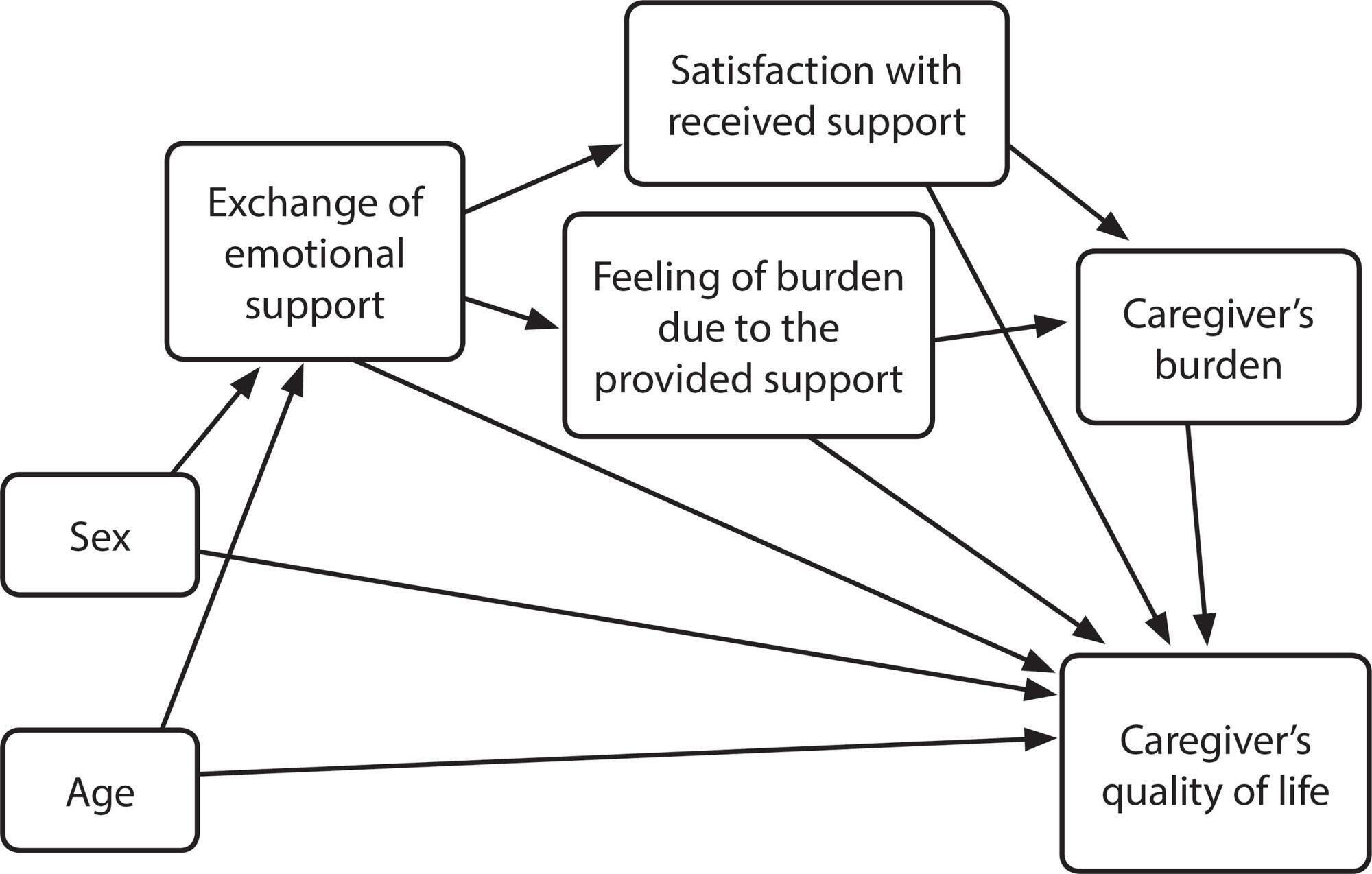
-
ORIGINAL ARTICLE09-16-2019
Social representations of the elderly about HIV/AIDS
Revista Brasileira de Enfermagem. 2019;72(5):1349-1355
Abstract
ORIGINAL ARTICLESocial representations of the elderly about HIV/AIDS
Revista Brasileira de Enfermagem. 2019;72(5):1349-1355
DOI 10.1590/0034-7167-2018-0296
Views0See moreABSTRACT
Objective:
to understand the representational content about HIV/AIDS among seropositive elderly people.
Method:
a qualitative study carried out from April to May 2017, in the city of Recife/PE, with 48 seropositive elderly people, through a semi-structured interview. The Social Representations Theory was used as theoretical framework and the method of lexical analysis through IRAMUTEQ software.
Results:
it was observed that the social representation of HIV is structured around the proximity of death and that it is a disease of restricted groups, leading to feelings of sadness. On the other hand, it is evident a transformation of the representation linked to the reified knowledge, leading to the process of naturalization of the disease.
Final considerations:
it is concluded that the elderly living with HIV, when they undergo a process of reframing about the disease, become more flexible to deal with their condition of seropositivity.
-
ORIGINAL ARTICLE04-22-2020
Indicators of effectiveness of nursing care in the dimension of patient safety
Revista Brasileira de Enfermagem. 2020;73(3):e20180833
Abstract
ORIGINAL ARTICLEIndicators of effectiveness of nursing care in the dimension of patient safety
Revista Brasileira de Enfermagem. 2020;73(3):e20180833
DOI 10.1590/0034-7167-2018-0833
Views0See moreABSTRACT
Objectives:
to validate nursing care effectiveness indicators of patient safety dimension.
Methods:
quantitative survey, using the electronic Delphi sampli, with 52 participants selected by the Snowball sampling. Eight indicators were evaluated regarding the attributes: availability, reliability, simplicity, representativeness, sensitivity, comprehensiveness, objectivity, cost, utility, stability and timeliness. For validation, the minimum agreement criterion was 70%.
Results:
Cronbach’s alpha (0.942) evidenced the high internal consistency among the attributes. The indicators fall with damage, hip fracture, and postoperative hip fracture, incidents related to equipment, incidents due to failures in patient identification, and pressure injury were validated in all attributes, and those of medication error and hand Hygiene were not validated.
Conclusions:
the validated indicators allow assessment of the effectiveness of hospital nursing care. Unavailability of data is an obstacle to monitoring patient safety.
Search
Search in:
Nuvem de Tags
Adolescente (85) Atenção Primária à Saúde (239) COVID-19 (91) Criança (91) Cuidados de Enfermagem (269) Educação em Enfermagem (151) Educação em Saúde (139) Enfermagem (930) Enfermagem Pediátrica (86) Estudantes de Enfermagem (77) Estudos de Validação (131) Família (87) Idoso (208) Promoção da Saúde (99) Qualidade de Vida (104) Saúde do Trabalhador (86) Saúde Mental (145) Saúde Pública (82) Segurança do Paciente (150) Tecnologia Educacional (100)



